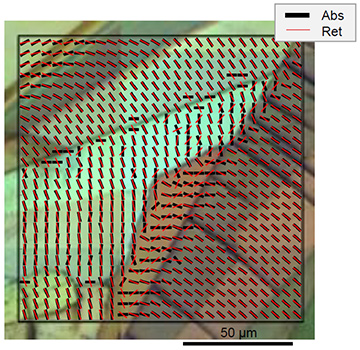 Optical cross-polarized image of paracetamol with overlaid IR image at the OH vibration band. Black and red markers show the orientation of the dichroic absorbance (Abs) and birefringence (retardance, or Ret). [Enlarge figure]
Optical cross-polarized image of paracetamol with overlaid IR image at the OH vibration band. Black and red markers show the orientation of the dichroic absorbance (Abs) and birefringence (retardance, or Ret). [Enlarge figure]
Sensors and optical characterization techniques depend on measurements of properties related to the real and imaginary parts of complex refractive index, n* = n + ik. Measurements from very small regions become affected by small, direction-dependent modifications of Δn and Δk—the birefringence and dichroism. Both properties are determined from angular dependences on the transmittance T(θ). In work published this year, we developed a method to determine dichroism and birefringence from a single measurement, with potential benefits for hyperspectral imaging.
Directions of strong (or weak) absorbance A and slow (or fast) optical axes with indices ne and no can be found. However, when A is measured, the spectral range is chosen at which n and Δn-related effects can be neglected, and we are thus able to retrieve k and Δk-related entities. Likewise, when A = 0, we determine the optical properties related to the real part, n and Δn = ne – no. Orientation of the optical axis thus becomes the basis on which to classify optical materials.
Why are absorbance (and dichroism) not measured at the same wavelength and time as birefringence? The answer lies in how Δn and Δk are measured, and in their different angular dependence. The angular dependence of transmission lg(T(θ)) = –α(θ)d through a sample of thickness d, where α is the absorption coefficient, defines the orientations of strong (or weak) absorbance and dichroism; for this measurement, one polarizer is used before the sample. To measure birefringence, in contrast, T(θ) is measured with sample rotated between two crossed polarizers. In this way, Δn and the orientations of slow (fast) axes can be determined; however, it can be done quantitatively only when A = 0.
In our recent work, we showed that two aligned polarizers, with the sample in-between, can decouple the optical loss due to absorbance and dichroism from birefringence, delivering an elegant way to determine dichroism Δk and birefringence Δn from a single measurement of T(θ).1 This is possible because absorbance follows a cos θ dependence (Beer-Lambert law, 1729), while birefringence changes as cos 2θ (Malus law, 1809). Our method combines the two laws by multiplication.1 The cos 2θ dependence of Δn reflects the fact that T is minimum when the light’s electric field is aligned with or perpendicular to the parallel-polarizer setup, while the absorbance is always defined by the electric-field projection onto the axis of the dipole transition, defining the cos θ dependence for Δk.
The proposed method allows absorbance to be separated from birefringence at the same wavelength and in the same measurement. It is most beneficial for hyperspectral imaging, which can be carried out in the IR-fingerprinting, UV/visible or THz ranges. Spectrum-per-pixel is augmented by the orientation dependence of Δn, Δk, and their amplitude, which is related to the local order.
Researchers
Meguya Ryu and Junko Morikawa, Tokyo Institute of Technology, Tokyo, Japan
Saulius Juodkazis, Swinburne University of Technology, Hawthorn, Australia, and Tokyo Institute of Technology, Tokyo, Japan
Reference
1. M. Ryu et al. Nanoscale Horiz., doi: 10.1039/C9NH00340A (2019).
